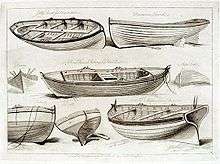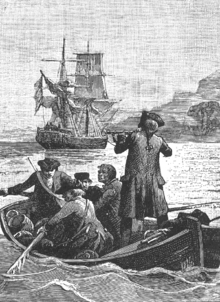Jolly boat
The jolly boat was a type of ship's boat in use during the 18th and 19th centuries. Used mainly to ferry personnel to and from the ship, or for other small-scale activities, it was, by the 18th century, one of several types of ship's boat. The design evolved throughout its period in service.

Origins
The term 'jolly boat' has several potential origins. It may originate in the Dutch or Swedish jolle, a term meaning a small bark or boat.[1] Other possibilities include the English term yawl, or the 'gelle-watte', the latter being a term in use in the 16th century to refer to the boat used by the captain for trips to and from shore.[1][2] The term appears in Chamber's Encyclopedia between 1727 and 1741, and as 'jolly' in the works of Frederick Marryat, though it may have been in use considerably earlier, as the record of the voyages of Francis Drake and John Hawkins has 'That day the Pegasus jolly was going on shore for water, carying no guarde. The Spaniards perceiving it came downe upon them.'[3]
Design and use

Jolly boats were usually the smallest type of boat carried on ships, and were generally between 16 feet (4.9 m) and 18 feet (5.5 m) long.[4] They were clinker-built and propelled by four or six oars.[1] When not in use the jolly boat normally hung from davits at the stern of a ship, and could be hoisted into and out of the water.[1][4] Jolly boats were used for transporting people and goods to and from shore, for carrying out inspections of the ship, or other small tasks and duties that required only a small number of people, and did not need the use of the larger boats, such as the launch or cutter. Jolly boats were carried on practically all types of warships of the Royal Navy during the age of sail, from ships of the line down to sloops and brigs.[5] Ships of the line would carry a barge, launch, pinnace, two cutters, all of various sizes, and a jolly boat, while the brigs might carry only a jolly boat and a cutter.[5]
The application of the jolly boat was developed further during the French Revolutionary and Napoleonic Wars, particularly by the frigate commander Sir George Collier.[6] Collier, who was active in the close blockade of the Spanish coast during the Peninsular War, combined the features of a jolly boat with those of a whaleboat and found the result extremely seaworthy and particularly effective in carrying out shore landings.[6] The design was particularly buoyant and was often described as a type of lifeboat. Several captains ordered these boats for their own ships, while the Admiralty considered the possibility of ordering a general replacement of old-style jolly boats with the new 'lifeboat' design on several occasions, but were deterred by the cost.[6] By 1815 however the Stores Committee had authorised the replacement of the old-style jolly boats with the improved versions as and when it proved practical for a ship's commander to carry this out.[6]
See also
- Betsey (schooner), tale of shipwrecked crew who took to a jolly boat
- The survivors of the sinking of the SS Anglo Saxon in 1940 who survived 70 days adrift in a jolly boat.
- HMY Britannia – now a floating museum in Leith, Scotland – carries two modern jolly boats in davits, one port and one starboard
Notes
- Oxford Companion to Ships and the Sea, p. 434
- Oxford Companion to Ships and the Sea, p. 340
- More Words Ancient and Modern, pp. 92-3
- Adkin. The Trafalgar Companion. p. 94.
- Lavery. Nelson's Navy. p. 70.
- Gardiner. Frigates of the Napoleonic Wars. pp. 108–9.
References
- Adkin, Mark (2007). The Trafalgar Companion: A Guide to History's Most Famous Sea Battle and the Life of Admiral Lord Nelson. London: Aurum Press. ISBN 1-84513-018-9.
- Gardiner, Robert (2006). Frigates of the Napoleonic Wars. London: Chatham Publishing. ISBN 1-86176-292-5.
- Kemp, Peter, ed. (1979) [1976]. The Oxford Companion to Ships and the Sea. Paladin. ISBN 0-586-08308-1.
- Lavery, Brian (1989). Nelson's Navy: The Ships, Men and Organisation; 1793-1815. Conway Maritime Press. ISBN 0-85177-521-7.
- Weekley, Ernest (1971). More Words Ancient and Modern. Ayers Press. ISBN 0-8369-5917-5.